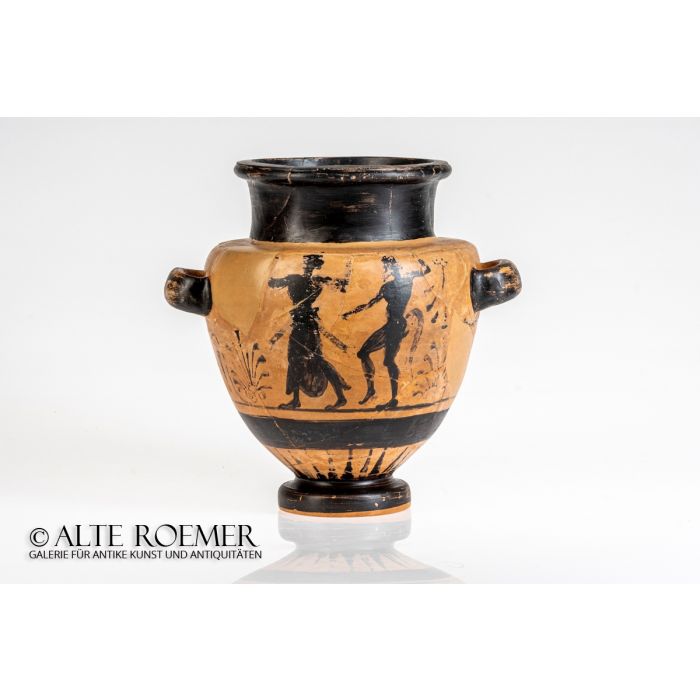Black figure Etruscan Stamnos from Toledo Museum collection
Price: on request
Sold
Object number
AR2985
| Object: |
Stamnos Ancient storage jar |
| Material: |
Red clay with black slip So-called black figure pottery |
| Date: |
About 2nd half 6th century BC Etruscan culture, imitating athenian black figure vases |
| Description: |
Ovoid body with high ring-shaped foot and wide flat shoulder. Broad cylindrical neck with massive lip. Two small flat handles are attached slightly below the shoulder. Foot covered with black slip. The lower body part decorated with rays of light, above broad black line and another thin line which serves as the ground line for the painted scenes which show a maenad dancing with a satyr on one side and another maenad dancing with a male youth on the other side. At both sides of the dancers and below the handles palmettes. Radiate beam decoration on shoulder. Neck and lip fully covered with black slip outside and about 40mm inside. Handles covered with black slip outside. |
| Size: |
Height 254 mm, Diameter about 200 mm without and 255 mm with handles.
|
| Condition: |
Professionally restored in 2019 by the conservator Ms. Mennerich (Germany) from several fragments, reconstructing some missing areas (about 20% of the body). The painted scenes are worn but still very well preserved. On lower side of foot "1861" in black and "12 [or TZ] 1238" in red color. Impressive large jar.
|
| References: |
See: Corpus Vasorum Antiquorum, Muenchen, Antikensammlung ehemals Museum antiker Kleinkunst 17, 111-112, Beilage 8.2, Pl. 61.2-4 Corpus Vasorum Antiquorum, Goettingen, Archaeologisches Institut der Universitaet 2, 71, Beilage 7.1, Pl. 41.1-3 For athenian vases which served as model for the etruscan potters and painters, see e.g.: American Journal of Archaeology: 113 (2009) 614, Fig.11 (A) (today in the collection of Universität Würzburg, Martin von Wagner Mus., Nr. L328) |
| Provenance: |
Acquired 2017 from a US auction house. Sold there from the collection of the Toledo Museum of Art (USA), where the stamnos was since 1912 (Inv.nr. 1912.1238). The Toledo Museum decided to sell off 145 objects from its collection to finance the acquisition of new objects. The stamnos came into the museum from the collection of Prof. Dr. George N. Olcott which was formed betwen 1899 and 1912 (object number S 1867 in the Olcott collection). It was acquired by the Toledo Museum in 1912 from the widow of Prof. Olcott, Mrs. Zita Ledderucci Olcott. Mr. Olcott was a professor of Latin and Roman Archaeology at the Columbia Unoverity, Ney York City, USA. Prof. Olcott acquired this Stamnos from the Italian private collection of Hon. Napoleone Brenciaglia (born March 13, 1861 in Capodimonte, defunct in Rome in 1925), Lake Bolsena, Italy. |
| Olcott collection: |
George Olcott was born September 19, 1869 in Brooklyn, N.Y. He studied at the Brooklyn Polytechnic Institute and later at Columbia University, from where he graduated with distinction in 1893. In 1896, Mr. Olcott won the Drisler Classical Philology scholarship and used this to study at the American Academy in Rome (at these times the American School of Classical Studies). After his return from Rome and receiving his PhD in 1899, Olcott started his teaching activities. During a sabbatical which he spent in Italy in 1911 - 1912, Prof. Olcott fell ill with pneumonia from which he died March 2, 1912. More information about Prof. Olcott and his collection can be found in: Ingrid E.M. Edlund, The Iron Age and Etruscan Vases in the Olcott Collection at Columbia University, New York, in: Transactions of the American Philosophical Society Vol. 70 Part 1 (Philadelphia May 1980) |
| Authenticity: |
We unconditionally guarantee the authenticity of every artefact, all items are subject to our lifetime return policy on authenticity.
|


